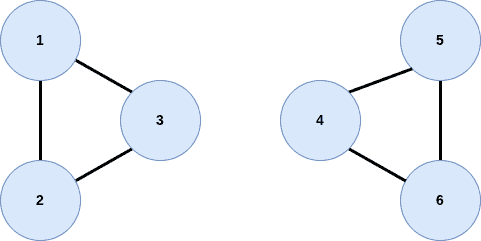1. 简介
在计算机科学中,图是一种用于表示对象之间关系的数学结构。图由节点(vertices)和边(edges)组成,边表示节点之间的连接关系。图的边可以是有向的,也可以是无向的。
本篇文章将介绍图中的“桥”(bridge),解释它的含义与重要性,并介绍检测桥的常用算法。
2. 什么是桥?
桥,也称为割边(cut edge),是图中一种特殊的边。如果移除某条边会导致图不再连通,那么这条边就是桥。
形式化地说,假设图表示为 G = (V, E),其中 V 表示顶点集合,E 表示边集合。如果某条边 (u, v) 是桥,意味着 u 和 v 之间不存在其他路径。如果移除该边,u 和 v 将不再相互可达,图会被分割成两个子图。
✅ 关键点:
- 桥的存在表明图的某些部分依赖于这条边保持连通。
- 移除桥将导致图的连通性下降。
2.1 桥的不同类型
- 树结构中的边:在树图中,每条边都是桥。因为树是无环的,移除任意一条边都会使树分裂。
- DFS 树中的前向边:在深度优先搜索(DFS)生成的树中,前向边连接一个节点与其后代。这类边有时也可能成为桥。
3. 示例说明
我们来看一个无向图的示例:

在这个图中,边 (3, 4) 是一个桥。如果我们移除它,图将被分割为两个互不连通的子图:

两个子图分别包含节点 {1, 2, 3} 和 {4, 5, 6}。此时,节点 1、2、3 无法通过任何路径到达节点 4、5、6。
⚠️ 注意:并不是所有边都是桥。例如边 (1, 2),即使被移除,图依然保持连通,因此它不是桥。
4. 桥的重要性
桥在图中代表关键连接,具有以下重要意义:
- 结构分析:桥的存在揭示了图的关键连接点,有助于理解图的拓扑结构。
- 网络设计:识别桥可以帮助网络设计者增强关键链路的冗余性,提高整体鲁棒性。
- 图算法应用:桥可用于计算最小生成树、检测环路等场景。
桥的数量与图中连通分量的数量密切相关。桥越多,图的结构越松散。
5. 检测桥的常用算法
5.1 DFS 算法(推荐)
DFS 是检测桥的最常用方法之一。其核心思想是:
- 构建 DFS 树
- 维护每个节点的发现时间(disc)和低链接值(low)
- 如果 low[v] > disc[u],则边 (u, v) 是桥
✅ 优点:
- 实现简单
- 时间复杂度为 O(V + E)
- 空间复杂度为 O(V)
5.2 Tarjan 算法(进阶)
Tarjan 算法是 DFS 方法的改进版本,能同时检测桥和强连通分量。
✅ 优点:
- 可用于有向图和无向图
- 能同时检测桥和割点(articulation points)
5.3 BFS 算法(不常用)
虽然 BFS 也可以用于检测桥,但不如 DFS 直观和高效。通常不推荐使用。
6. 总结
桥是图中维持连通性的关键边。识别桥有助于:
- 理解图的结构
- 提高网络的鲁棒性
- 支持图算法设计(如最小生成树)
检测桥的常用方法包括 DFS 和 Tarjan 算法。它们在时间复杂度和实现难度上各有优势,但在大多数实际场景中,DFS 是首选。
虽然并非所有图都包含桥,但现实世界中的大规模网络通常都存在桥,识别它们对于网络设计和分析至关重要。